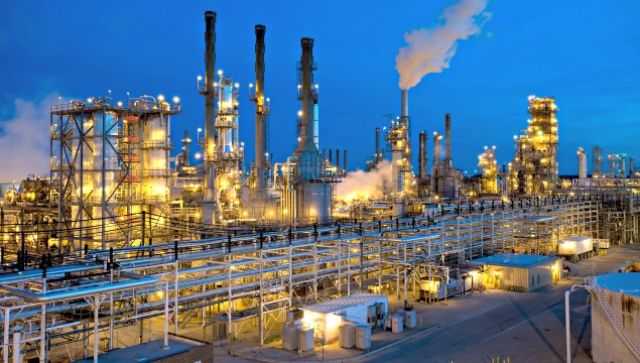
Marathon Petroleum Co.’s refinery in Robinson, Ill., has a capacity of 206,000 barrels per day, producing products such as gasoline, diesel, jet fuel, anode-grade coke and propane. Source: Marathon Petroleum Co.
Established in the 1970s as a terse reaction to the Arab oil embargo, the U.S. prohibition on exporting crude oil is facing its own midlife crisis. And the politicians who regulate the crude, the producers who sell it, the midstream firms who move it and the refiners who use it are all wrangling over how best to make the next few years golden.
Before industry leaders figured out how to tap the nation’s shales, it was fairly simple for the nation to luxuriate in an isolationist posture. There was unquestionably not enough crude produced domestically to consider shipping off a single drop of the precious resource.
But current forecasting by the U.S. Energy Information Administration projects that total U.S. crude production will reach 9.6 million barrels per day (MMbbl/d) by 2019—that’s up from 7.7 MMbbl/d in 2013. Meanwhile, crude imports are also expected to climb to almost 8 MMbbl/d by 2050.
Supply and demand
The disjointed supply and demand equation is exacerbated by several factors. To begin, much of that new crude is light, sweet and is produced in locations, such as the Eagle Ford in South Texas, that aren’t close to refineries designed to handle a light crude feedstock. That can lead to an oversupply in places like the Gulf Coast, where refineries are configured for heavy, sour crude, and a glut of the light stuff could lower the price for U.S. oil. That may work for refiners and manufacturers, who would benefit from an oversupply of their feedstock, but not so much for the producers who want the best price for their production.
The referee here is still the federal government, and movement there can be a challenge for the industry to predict. Still, Energy Secretary Ernest Moniz told Washington, D.C., reporters recently that the Obama administration is, in fact, considering whether to relax the regulations that ban outright crude exports.
“A driver for this consideration is that the nature of the oil we’re producing may not be well matched to our current refinery capacity,” he said.
Some observers, however, say the immediate answer isn’t exporting more oil.
“While we may experience a glut of oil in the Midwest and the Gulf Coast, because the markets in that part of the country are not as robust as the East Coast or the West Coast, the fact is we have created disablers preventing us from moving the glut of American oil in the Midwest to either the East Coast or the West Coast,” former Shell Oil Co. president John Hofmeister told Midstream Business. “I think it is an issue that should be tackled before we start exporting oil from the middle of this country to the rest of the world.”
Hofmeister points to Jones Act restrictions that preclude U.S. oil from traveling on non-U.S. manufactured and maintained ships between domestic ports, as well as the expense to build new pipelines, as the first issues to be tackled.
“I’m not against exporting oil in principle, but on the other hand, I’m not in favor of exporting oil as a convenience when in fact, we are still so reliant on foreign imports on both coasts,” he said.
According to the American Petroleum Institute (API), lifting current restrictions could result in another $38 billion in economic growth in 2020, with an average GDP increase of up to $27 billion each year through 2035.
“This is a new era for American energy, but our energy trade policies are stuck in the 1970s. The U.S. and China are the only major oil producers in the world that don’t export a significant amount of crude. It’s time to unlock the benefits of trade for U.S. consumers and further strengthen our position as a global energy superpower,” API’s Kyle Isakower, vice president for regulatory and economic policy, said during a recent news conference.
The industry lines
One of the industry’s most vocal supporters of lifting the ban on crude has been Harold Hamm, chairman and CEO of Continental Resources Inc. He noted in an opinion piece in the May edition of Oil and Gas Investor that the U.S. already exports petroleum in the form of refined products.
Hamm likens the current situation to one in which American farmers couldn’t export wheat while allowing Pillsbury to export the flour it makes from the commodity. In terms of refined petroleum, the U.S. exports 4 MMbbl/d, Hamm said.
“It’s disingenuous for the government to ban exports of crude oil, yet allow exports of gasoline, diesel and propane,” he said. “By imposing trade restrictions on a single segment of the energy industry, our government is arbitrarily subsidizing refineries by giving them the ability to buy American oil at artificially low prices yet sell petroleum products into higher-price global markets.”
Phillips 66 CEO Greg Garland has been on record for two years saying the company isn’t opposed to lifting the ban, and he reiterated that position during a May roundtable with reporters. However, he added that it’s time for an open, honest dialogue about energy policy in the U.S. as a whole.
“We do believe in free markets. We export crude today through refined products. We’re not opposed to crude exports. We’re not opposed to NGL exports. We’re not opposed to plastic exports, and so we think free trade works best,” he said. “We think you’ve got to have open access—that means pipelines, that means ships—you’ve got to look at that whole equation in terms of: Is this a free market or not?”
Rival refiner Valero Energy Corp. has taken a harder line on crude exports. Noting that some crude exports are permitted via federal license, including one Valero was granted earlier this year, spokesman Bill Day said in an email to Midstream Business that, “Valero supports the current system that allows for licensed exports of crude oil.”
An election year
It wouldn’t appear to most that change is on the horizon. Garland noted that during an election year, major changes to energy policy are unlikely.
“It’s going to be difficult for Congress to move on this issue, simply because they have too many other things on their plate. Also, I think if you ask the average person on the street, ‘If the U.S. were to export crude, would gasoline prices go up or down?’ They would probably tend to say that they would go up,” he said. “So I think politically, it’s a very difficult thing right now.”
Given the partisan tenor of the debate, any sort of major energy reform is unlikely, said Hofmeister, who now serves as CEO of Citizens for Affordable Energy, an advocacy group.
“I have zero confidence that this president or this Congress will do anything that benefits the oil and gas industry because the leader of the nation has essentially trashed the industry for the five years of his administration, nearly going on six,” Hofmeister told Midstream Business. “And the Congress is so divided, thanks to the American people for putting a check and balance into the legislative branch to prevent the bad policy … But that, unfortunately, results in no policy.”
To be sure, Congress is struggling to pass controversial energy legislation this year. In May, an agreement to consider legislation to let members bypass the president on permitting for the Keystone XL Pipeline failed when Senate Republicans tried to piggyback other controversial amendments onto the bill. Those included measures to speed up natural gas exports and halt new climate change regulations by the Obama administration. Senate Majority Leader Harry Reid, D-Nev., objected, saying Republicans were playing a “shell game” by changing their demands at that point in the process.
That’s the sort of “partisan perversity” that Hofmeister said will keep energy reform at bay.
“I expect no legislation, no leadership, that is of any use to the oil and gas industry during this administration or this Congress,” he said.
Ex Parte Crude Exports
By Deon Daugherty
Although senior advisers in the White House have admitted the administration is looking into whether current refinery capacity can absorb increased production—and whether exports might be a suitable alternative if they can’t—analysts at Simmons & Co. International in Houston say legislative movement is unlikely, based on fears that gasoline prices would rise in an election year.
But meanwhile, the U.S. Department of Commerce already has the ability to approve exports, re-exports and swaps in deals deemed to be in the nation’s best interest. Simmons noted that approvals of those transactions have increased in recent months.
By the end of the 2013 fiscal year last September, the U.S. Department of Commerce had approved a total of 103 export licenses, 88% of which related to Canada, with the rest split between Central and South America. During the first seven months of fiscal year 2014, the previous year total was reached with 103 licenses, half of them related to Canada and others for shipments to the U.K. and Spain. In 2014, there have been several first-time approvals for shipments to Asian countries, including South Korea, Malaysia and Japan.
Certain small amounts of U.S. crude are permitted to be exported if the barrels to be licensed meet these criteria described by the U.S. Energy Information Administration:
- Crude derived from fields under the state waters of Alaska’s Cook Inlet;
- Alaskan North Slope crude oil;
- Certain domestically produced crude destined for Canada;
- Shipments to U.S. territories; and
- California crude to Pacific Rim countries.
Enbridge Inc. confirmed its plan in April, when the company told Reuters its U.S. subsidiary, Tidal Energy Marketing Inc., would re-export some Canadian oil from a U.S. port. The company intended to export less than 1.5%, close to 36,000 barrels per day of its total U.S. shipments, a spokesperson said.
San Antonio-based refining giant Valero Energy Corp. is one of two companies—the other being Enbridge Inc.—that has obtained such a license this year. Valero is on record as supporting the status of U.S. crude exports, which bans most of them.
“Valero is an exporter of crude oil,” said Valero spokesman Bill Day in an email to Midstream Business. “We have a license to export Eagle Ford crude oil from Texas to Canada, where we have a refinery that processes Eagle Ford, and we recently obtained a license to re-export Canadian light crude oil that comes to the Gulf Coast by rail up to Canada or over to the U.K.”
Recommended Reading
Wayangankar: Golden Era for US Natural Gas Storage – Version 2.0
2024-04-19 - While the current resurgence in gas storage is reminiscent of the 2000s —an era that saw ~400 Bcf of storage capacity additions — the market drivers providing the tailwinds today are drastically different from that cycle.
Biden Administration Criticized for Limits to Arctic Oil, Gas Drilling
2024-04-19 - The Bureau of Land Management is limiting new oil and gas leasing in the Arctic and also shut down a road proposal for industrial mining purposes.
SLB’s ChampionX Acquisition Key to Production Recovery Market
2024-04-19 - During a quarterly earnings call, SLB CEO Olivier Le Peuch highlighted the production recovery market as a key part of the company’s growth strategy.
PHX Minerals’ Borrowing Base Reaffirmed
2024-04-19 - PHX Minerals said the company’s credit facility was extended through Sept. 1, 2028.
Exclusive: The Politics, Realities and Benefits of Natural Gas
2024-04-19 - Replacing just 5% of coal-fired power plants with U.S. LNG — even at average methane and greenhouse-gas emissions intensity — could reduce energy sector emissions by 30% globally, says Chris Treanor, PAGE Coalition executive director.





